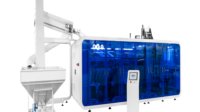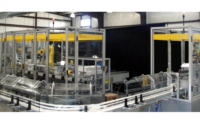Automation
Flexibility: The Key to Packaging Productivity
The effective integration of flexible robotic solutions can help manufacturers and suppliers achieve game-changing results for production line performance.








In a market where customer demands are ever-changing and growing in complexity, the ability to handle shorter production runs with greater packaging variation is essential for manufacturers wanting to maintain profitability. Consumer pressure for greater product personalization, healthier food alternatives, transparent ingredient traceability, environmentally friendly materials and more is steadily increasing, prompting the transformation of production operations — especially where packaging is concerned.
To manage the uptick for the product differentiation that is needed to keep competitive, many manufacturers are moving from fixed automation environments and the use of task-specific machinery to flexible automation layouts that include more adaptive machinery. For this reason, companies across numerous industries are implementing robotic solutions to maintain packaging productivity while increasing profit.
Technological advancements have prompted the creation of cheaper, faster and more versatile robots for many primary and secondary packaging tasks, while higher payload, long-reach models have optimized end-of-line packaging. But what exactly does robotic automation as a whole bring to the packaging space that has the global packaging robot market forecast to grow at a compound annual growth rate (CAGR) of nearly 10% through 20211?
Easy-to-Use Robots
Whether the industry of focus is food and beverage, pharmaceuticals, other consumer products or specialty items, success in packaging hinges on consistency and efficiency. For this reason, manufacturers are relying on more sophisticated automation layouts that utilize reliable easy-to-use robots that can expertly handle the versatility, capacity and repeatability required to succeed.
Compact six-axis robots with high acceleration speeds are easier to program than ever, allowing quick and easy implementation of a robot system. Equipped with intelligent tablet-based teach pendants that utilize leading human machine interface (HMI) features, a “click and program” approach is enabling operators to guide a robot using familiar commands. Moreover, the innovative teach pendant, the Yaskawa Smart Pendant, possesses built-in Smart Frame technology that enables the robot to adapt to the operator’s position. This makes the programmer the frame of reference and eliminates the use of conventional coordinate (X, Y, Z) frames for an easier learning curve.
Ideal for fast deployment and redeployment on demand, highly versatile and portable collaborative robots offer up to four modes of collaboration (Safety Monitored Stop, Speed & Separation Monitoring, Power & Force Limiting and Hand Guiding) to provide manufacturers with the flexibility, efficiency and safety needed to empower humans to work with, or alongside, robots to complete a defined task. Based on a thorough risk assessment, emerging technologies like this are facilitating fluid interaction between robots and human workers, creating a highly productive workforce in a timely manner to reduce costs and minimize downtime.
Singular Control Environment
Not only are robots becoming easier to program, but also the complete control of every component in a given network is now easily manageable. This is especially true for material handling, picking, packing and palletizing applications. Whether a system is designed for a single job or combination of tasks, the use of a Programmable Logic Control (PLC) or motion controller environment can now provide robot operators with a user-friendly approach to automation implementation where:
- A robot can be added to existing automation, not requiring a separate programming language.
- An easy-to-use library of function blocks and sample programs are provided for programming ease.
- A full set of HMI screens reduces the time and effort required to implement a system.
- A company’s prior investment in programmable logic controllers (PLCs) staff is protected — programmers may not need to learn an entirely new robot programming language and can easily take ownership of their robotic applications.
Furthermore, interfaces like Yaskawa’s MLX300 system — where a combination of up to four robots and positioners can be connected — provide robust options that enable the programming and singular control of multiple mechanisms. A broad range of industrial robots, servo systems and variable frequency drives can work seamlessly together under the complete control and monitoring of a single IEC machine controller, such as the MP3300iec controller running MotionWorks IEC software that is compatible with multiple programming languages.
No matter the complexity of an operation, control architecture can often improve packaging production, accelerating ROI. Robots and technologies are implemented with minimal programming and greater ease. This approach also helps to simplify safety design by eliminating redundant electrical interfaces and consolidating hardware to optimize floor space.
Ease of Changeover
Many companies must run multiple products on their lines, and they need to have the ability to perform rapid changeover to accommodate the demands of a high-mix, low-volume market. Furthermore, minimizing investment while maintaining productivity is a common industry theme that runs deep. Subsequently, many manufacturers are adding robots to existing lines or implementing entire robotic systems that easily accommodate a variety of part form factors without the need for aggressive tool exchange and more. This type of automation flexibility is a modern-day necessity, especially where changeover is concerned.
Changeover that relies on manual labor can be time-consuming and expensive; however, the high-speed changeover that robotic automation provides optimizes machine uptime, increasing Overall Equipment Effectiveness (OEE). While changeover can be bolstered in multiple ways, application requirements often prompt manufacturers to implement robotic technology with the following:
- Easy-to-Clean Surfaces: For food or consumer product packaging environments, robots designed with an IP67-rated surface can resist dust and fluids, making them ideal for use in sanitary or harsh environments. The less time that is needed to clean the robot during changeover, the faster it can be up and running.
- Vision-Guided Robotics (VGR): High-tech imaging systems are able to find an object and provide an acceptable and precise location to a robot, helping them be more adaptable to the surrounding environment. From cost-effective and easy-to-integrate 2D vision systems for the recognition of structured and semi-randomly placed products, to next-generation 3D vision solutions for the accurate single-step recognition of randomly placed products, machine vision technology can alleviate the time spent on calibration during changeover.
- End-of-Arm Tools (EOAT): From retail to food and beverage, robotic grippers and tooling are being designed with greater demand in mind. Durable multi-function end effectors capable of performing different tasks and handling a variety of shapes with ease are minimizing downtime during changeover.
Multi-Application Capability
Current packaging systems need to be able to handle more versatility than ever — bottle packing one day and palletizing the next. This demand for faster changeover and shorter production runs with more diverse pack styles, form factors and sizes is prompting many small- and medium-sized manufacturers to implement compact and portable multi-application systems to gain the flexibility needed to meet customer requirements.
For this reason, integration companies have created pre-engineered solutions to ensure timely and reliable product production. These off-the-shelf work cells are attractive to manufacturers for several reasons. Smaller footprint designs save valuable floor space, while step-by-step setup and user-friendly interfaces allow quick utilization after installation. Fully integrated, these systems come with the necessary robots and technologies — conveyors, cameras, sensors, EOAT, etc. — to handle a broad and varied mix of products and SKUs.
Other Considerations
Production line performance is critical to corporate success, and the effective integration of flexible robotic solutions can help manufacturers and suppliers achieve game-changing results. End user demands are such that manufacturers are rethinking application processes and workspace layouts to boost production. In light of this, several final aspects should be considered:
- Product Design: Some manufacturers seek the help of robot OEMs and integrators in the early stages of packaging design to consult on whether a product will be suitable for automation. From liquid viscosity to container design, and everything between, creating products and packaging with automation in mind enables more predictable outcomes for the packaging solution.
- Retrofitting: While replacing current equipment with robotic automation can be effective, it is not always the most cost-effective or efficient solution for a company. Sometimes, modernizing capital equipment, or adding a single robot to an existing work cell, is effective enough to boost product throughput for greater ROI.
- Workflow: From start to finish, there are many variables to conceptualize and coordinate when making a product. Often overshadowed by product design or robot specifications, strategic mapping and simplification of workflow should not be overlooked. New robotic solutions should be implemented in such a way that workflow is enhanced, avoiding factory floor traffic jams.
- Real-Time Machine Monitoring: Though it is not necessary to use a software platform to manage production environments, it lends large benefits. The real-time data collection and visualization capabilities inspired by Industry 4.0 allow companies to synchronize all factory equipment and monitor system performance and health for the implementation of data-driven optimized planning.
With corporate spending expected to increase for packaging production2, the time is right for manufacturers still “on the fence” about implementing new technologies for flexible packaging operations to move forward.
- Global Packaging Robots Market 2017-2021, Technavio, 2017
- The 2018 Brand Owner Packaging Survey, L.E.K. Consulting, 2018
Founded in 1989, the Motoman Robotics Division of Yaskawa America Inc. is a leading robotics company in the Americas. With over 450,000 Motoman industrial and collaborative robots installed globally, Yaskawa provides innovative automation products and solutions, including the new Smart Series line that allows quick and easy implementation of a robot system. All of our solutions are backed by our unwavering commitment to provide exceptional customer service, world-class training and after-sale support to ensure your complete satisfaction. Visit motoman.com for more information.
Looking for a reprint of this article?
From high-res PDFs to custom plaques, order your copy today!










